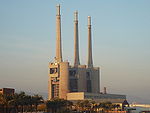Energy in Montecara
Energy in Montecara is a matter of immense national importance given the city-state's lack of natural resources and energy-hungry industries. Montecara is an intensive energy user and must import virtually all of its energy resources.
Coperatìva Montecarà de eletrìçita e gas, operating under the trade name Comega, is the utility cooperative providing natural gas and electricity. It is a consumer cooperative owned and managed by its customers under a charter granted by the Montecaran state. As a cooperative, Comega is owned by its customers and governed democratically. It is not, importantly, a state-owned enterprise, nor is it a legal monopoly; private entities as well as the state are allowed under the law to generate their own power and indeed to sell it to Comega under a net metering scheme approved in 2006. It applies the cooperative principles in its operation, which is based on a charter granted to it by law in 1925 and which took effect January 1926. Operating surpluses and profits are not paid out as dividends; instead, members decide how best to use them in an annual vote. In the past, members have chosen to invest in modernizing transmission technology, expand the use of wind and solar, and create a subsidy fund for low-income members.
Montecara imports approximately 425,000 barrels of oil per day, or 155.125 million barrels per year. It has no domestic oil sources. It consumes 395,350 barrels per day, for a consumption per capita of 225.70 barrels per day per 1,000 people—the highest rate in the world. The vast majority of Montecara's oil imports are used for transportation, both in the form of cars and trucks and by the ships that use Montecara as a fueling station. Twin oil and natural gas pipelines run from Tsabara to mainland Euclea underneath Montecara. These are tapped off for use in power plants and transportation. These pipelines provide the vast majority of oil and gas resources used locally, but some oil and liquefied natural gas arrives by ship as well and is usually re-exported.
Some efforts have been made to reduce Montecara's oil dependency and blunt the worst effects of burning large quantities of fossil fuels. VM is in the process of converting its entire bus fleet away from fossil fuels. It began to replace aging diesel buses with compressed natural gas vehicles in the late 1990s and is now replacing old equipment with all-electric models. The state charges higher registration fees to vehicles with poor fuel efficiency. Diesel fuel sold in Montecara must have a minimum cetane number of 53 and a maximum sulfur content of 10 ppm; this includes the fuel oil burned in Montecara's power plants. Bunker C fuel is banned from use in Montecaran waters. Additionally, all marine fuel must have a maximum sulfur content of 0.1%. This essentially limits marine fuel options to Bunker A or lighter.
The Secretariat of Planning and the Environment has authority over energy regulation in Montecara.
Electricity
| Data | |
|---|---|
| Electricity coverage | 100% |
| Continuity of supply | 99.99% |
| Installed capacity (2017) | 4795 MW |
| Share of fossil energy | 92.28% |
| Share of renewable energy | 7.72% |
| Average electricity use (2019) | 4,794 kW·h per capita |
| Services | |
| Share of private sector in generation | 100% |
| Competitive supply to large users | No |
| Competitive supply to residential users | No |
| Institutions | |
| Responsibility for transmission | Comega |
Montecara consumes about 8.397 billion kW·h of electricity per year. The government claims that the country is in the process of moving away from fossil fuels and toward sustainable energy, but it badly lags behind schedule in its goal, set in 2000, of achieving 100% renewable electricity by 2025. Less than ten percent of the electricity generated in Montecara comes from a renewable source, with the remaining more than ninety percent coming from oil and natural gas. There are several obstacles to the increased use of renewables: limited land area means that there is little free space to deploy solar panels, the terrain is not generally favorable to onshore wind power, and high land values mean that land-intensive renewable plants are prohibitively expensive to build and maintain. Moreover, the continuous and cost-competitive supply of oil and gas from Tsabara means that renewables cannot compete on price. An interconnector cable allows electricity to be exported to and imported from mainland Euclea as needed.
Nuclear power is a highly contentious political issue. Montecara has been a nuclear-free zone since 1985 in response to plans by Comega to build a boiling water reactor.
Power plants
| Name | Image | Type | Capacity (MW) | Commissioned |
|---|---|---|---|---|
| Nùvol power plant | Natural gas (primary) Oil (secondary) |
1050 (3 × 350) | 1982 | |
| Siròco Nòvo array | Offshore wind | 309 | 2013 | |
| Cocàl regeneration plant | Waste-to-energy | 85 | 1999 |



